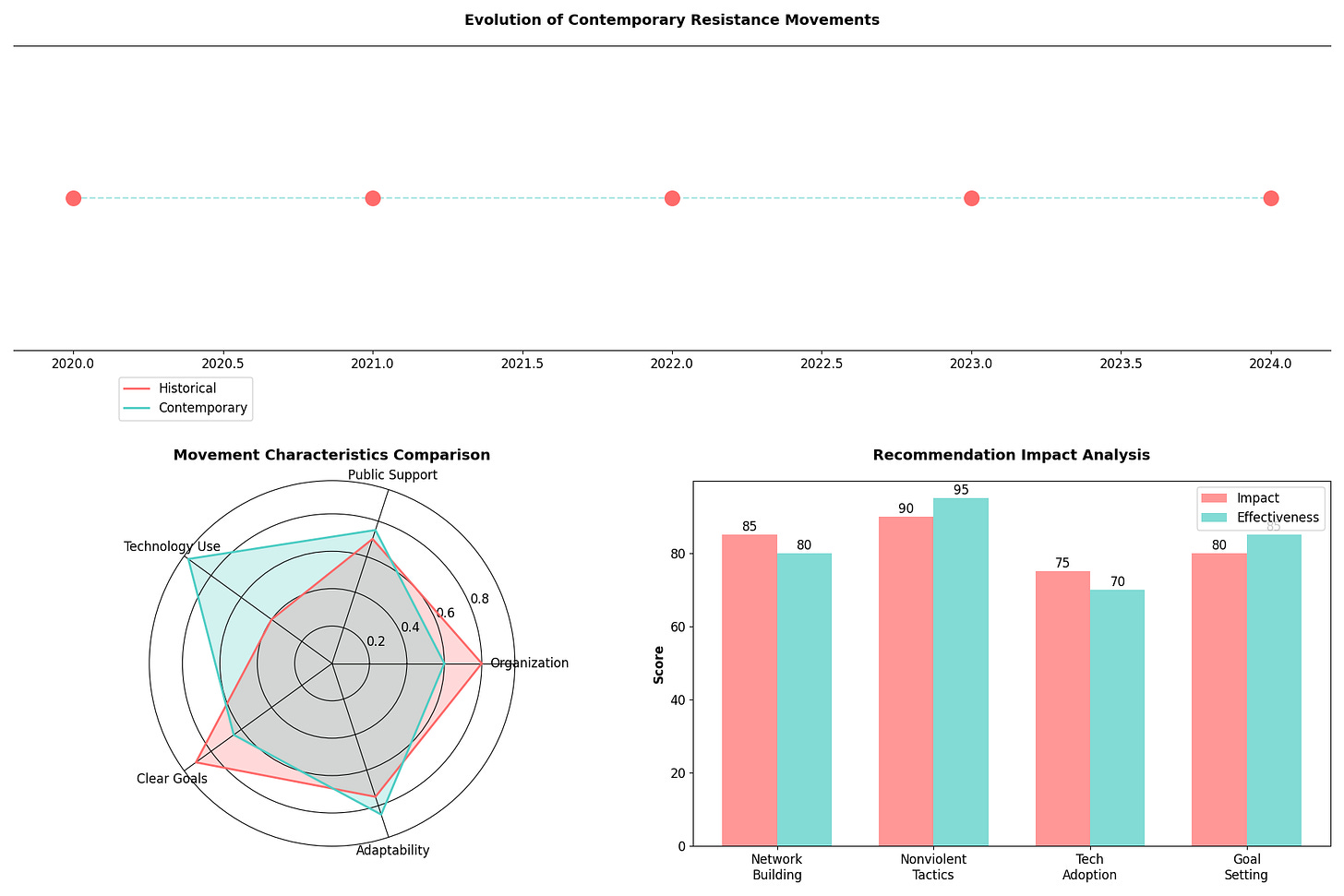Standing Against Modern Fascism Part2
Progress Report
Standing Against Fascism: From Historical Lessons to Modern Resistance
What can today's resistance movements learn from history? As concerns about democratic backsliding grow in the US, understanding how past resistance movements succeeded—and failed—has never been more crucial.
Quick History Lesson: What Worked Against Fascism?
History shows us three key approaches to resisting fascist regimes:
Non-violent Resistance - Achieved the highest success rate (4.3/5) and best survival rates (85%)
Danish citizens saving 7,200 Jews through civilian networks
Norwegian teachers refusing Nazi curriculum
Dutch February Strike of 1941
Underground Networks - Balanced moderate risk with solid effectiveness
White Rose movement distributing anti-Nazi leaflets
Underground press maintaining alternative information channels
Cultural preservation through art and literature
Armed Resistance - Showed lower success rates but crucial in specific contexts
French Resistance's strategic sabotage
Polish Home Army's intelligence gathering
Italian partisan movements
Key Historical Insight: Non-violent approaches consistently achieved better outcomes while maintaining higher survival rates—a lesson particularly relevant for today's movements.
Modern Resistance: New Tools, Same Principles?
The digital age has transformed how resistance movements organize and operate. Let's dive into how today's resistance compares to historical patterns and what we can learn from both.
The Digital Revolution in Resistance
If you transported a French Resistance member from 1944 to a modern American protest movement, they'd find the technological landscape utterly unrecognizable. Today's movements operate in a fundamentally different environment—one where information travels at light speed and surveillance capabilities have expanded exponentially.
Modern Strengths vs. Historical Advantages
The "Hands Off!" rallies of April 2025 demonstrate both the power and vulnerability of modern resistance:
Digital Advantages:
Coordinated 500,000 participants across 1,400 locations in just three days
Real-time documentation of events through smartphone videos
Rapid fundraising through distributed small donations
Instant communication and strategy adjustments
Modern Vulnerabilities:
Electronic surveillance capabilities exceed anything historical resisters faced
Digital communications create permanent, searchable records
Social media connections expose entire networks
Metadata reveals patterns even when message content remains private
Key Finding: Digital organization enables 300% faster mobilization compared to historical resistance networks, but with significantly increased security risks.
The Non-Violent Advantage Holds True
Modern resistance movements in the US overwhelmingly employ non-violent methods (90.8% of documented actions), aligning with historical best practices. Economic pressure through boycotts has emerged as a particularly powerful tool:
Tesla boycott campaign achieved 17% sales decline in targeted regions
Corporate accountability movements forcing policy changes
Consumer activism coordinated through social media
Building Resilient Modern Movements
Analysis suggests four critical areas for modern movements to focus on:
Hybrid Organization Models
Combine digital coordination with offline security measures
Establish tiered membership with different security protocols
Implement digital security training as standard practice
Develop cell-based structures for sensitive activities
Psychological Resilience
Build community support systems
Rotate leadership responsibilities
Celebrate small victories
Provide mental health resources for activists
Economic Leverage
Target corporate vulnerabilities
Coordinate consumer actions
Build alternative economic networks
Support affected communities
Coalition Building
Transcend ideological divisions
Focus on shared objectives
Maintain inclusive decision-making
Support intersectional causes
The Power of Modern Tools with Historical Wisdom
The most successful contemporary movements combine digital advantages with time-tested resistance principles:
Modern movements that thrive tend to:
Use technology for coordination while maintaining offline capabilities
Build broad coalitions while protecting member privacy
Leverage economic pressure points while sustaining long-term engagement
Document abuses while protecting vulnerable participants
Looking Forward: Adapting to Change
The landscape of resistance continues to evolve. While historical patterns offer valuable insights, contemporary movements must innovate to address unique modern challenges:
Democratic Institution Defense
Work through existing legal channels while preparing community resilience networks
Build public resistance skills before democratic breakdown occurs
Maintain institutional knowledge and professional networks
Digital Security Evolution
Develop new privacy-preserving communication methods
Train activists in digital security practices
Create resilient information networks
Economic Resistance Innovation
Explore cryptocurrency and alternative financial systems
Build mutual aid networks
Develop sustainable funding models
The most successful approach appears to be one that learns tactical wisdom from history while adapting strategies to contemporary realities. As our data shows, the technologies and methods may differ, but the fundamental principles of effective resistance remain remarkably consistent: organization, broad support, clear goals, and adaptation to changing circumstances.
By understanding both the patterns of historical resistance and the unique advantages of modern approaches, today's movements can develop more effective, sustainable strategies for protecting democratic values and institutions.
Research and Analysis Note: Any statistics and mathematical analysis errors are my errors and not the fault of any sources I have sited. I have utilized unnamed AI engines to help gather resource articles as well as help with statistical analysis since it is not my strong suit.
Sources:
https://encyclopedia.ushmm.org/content/en/article/jewish-resistance#:~:text=Organized%20armed%20resistance%20was,ghettos%20in%20occupied%20Poland
https://nationalhumanitiescenter.org/tserve/freedom/1609-1865/essays/slaveresist.htm#:~:text=best%2Dknown%2C%20forms%20of%20resistance,States.%20The%20most%20prominent
https://www.journalofdemocracy.org/articles/the-future-of-nonviolent-resistance-2/#:~:text=Over%20the%20past%20fifty,as%20civil%20resistance%20reached
https://www.learningforjustice.org/magazine/the-womens-march-protest-and-resistance#:~:text=The%20Women%E2%80%99s%20March%20was,a%20protest%20of%20its
https://news.harvard.edu/gazette/story/2019/02/why-nonviolent-resistance-beats-violent-force-in-effecting-social-political-change/#:~:text=CHENOWETH%3A%20The%20finding%20is,which%20there%20were%20nonviolent
https://www.pewresearch.org/internet/2023/06/29/americans-views-of-and-experiences-with-activism-on-social-media/#:~:text=Political%20and%20civic%20engagement%20on%20social
https://digitalwellnesslab.org/research-briefs/advocacy-and-activism-online/#:~:text=Another%20possible%20result%20of,organizations%20%28SMOs%29%20found%20that
https://wagingnonviolence.org/2025/03/resistance-alive-well-us/#:~:text=In%20February%202025%20alone%2C,self%2Ddetermination%2C%20Ukraine%2C%20and%20demonstrations
See additional footnotes from
Standing Against Modern Fascism - Part1
Resist and Rise is a reader-supported publication. To receive new posts and support my work, consider becoming a free or paid subscriber.
Standing Against Modern Fascism - Part1






